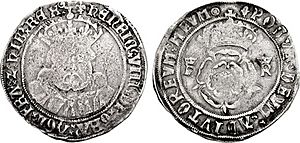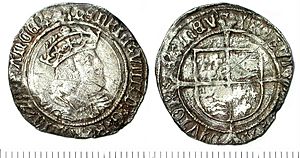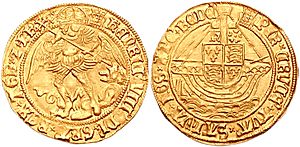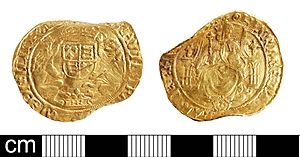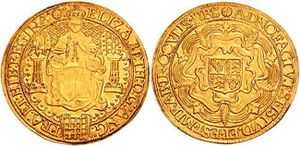The Great Debasement facts for kids
The Great Debasement (1544–1551) was a big change to England's money system. King Henry VIII started it in 1544. It meant that gold and silver coins had less valuable metal in them. Sometimes, cheaper metals like copper were used instead.
Henry VIII spent a lot of money on his fancy lifestyle. He also paid for wars with France and Scotland. These were the main reasons he started this policy. The king wanted to make more money for the country without raising taxes too much. By using less gold and silver, it cost less to make new coins.
During this time, the amount of gold in coins dropped a lot. It went from 23 karat to as low as 20 karat. Silver also went down from 92.5% pure to just 25%. King Edward VI stopped this policy in 1551. But its effects on the economy lasted for many years. All the "bad" money was finally taken out of circulation in 1560.
Contents
Why the King Changed the Money
In the 1500s, Europe was growing richer. Trade was increasing, and new gold and silver were found. But England was having money problems. In the 1540s, King Henry VIII spent huge amounts of government money. He used it for his own lavish life and for wars.
To get money, Henry had already done many things. He closed monasteries and sold their land. He also raised taxes. But he still needed more cash. In 1542, Henry secretly ordered that coins should have less gold and silver. He also brought back a coin called the Testoon.
For two years, these new, less valuable coins were kept secret. They were stored in the Jewel Tower in London. Meanwhile, normal coins were still being made. By 1544, there wasn't enough pure metal for coins. So, the government let the new, debased coins be used by everyone.
Just two months later, traders in other countries noticed. They saw that new silver coins were not as good. They started offering less money for them. When these cheaper coins appeared, the older, more valuable coins disappeared. People kept the good coins and spent the bad ones. This idea is known as Gresham's law.
More Changes Under Henry VIII
The amount of gold and silver in coins kept dropping under Henry VIII. In 1545, gold was reduced to 22 karat. Then, in 1546, it went down to 20 karat. Silver also dropped many times. It went from 92.5% pure to 50% in 1549, and then to just 33% in 1546.
Copper was used instead of silver in many coins. The Testoon coins Henry had made were covered with a thin layer of silver. But this silver often wore off. It wore off especially on the king's nose in his portrait on the coin. This showed the copper underneath. Because of this, Henry VIII was nicknamed "Old Coppernose"!
Changes Under Edward VI
Henry VIII died in 1547. His son, Edward VI, became king when he was only nine years old. The policy of making coins with less valuable metal continued under Edward. However, in 1548, they tried to make gold coins better. They increased the gold to 22 karat. This was called "crown gold." But to do this, the coins had to be made smaller.
The amount of silver in coins reached its lowest point in 1551, at just 25%. The debasement policy officially ended in October 1551. After that, silver coins went back to being 92.5% pure, just like before the debasement.
Coins Used During This Time
During the seven years of the Great Debasement, the amount of gold and silver in coins changed a lot. Their weights also varied. Here are some of the coins that were used:
- Sovereign
- Half sovereign
- Angel
- Half-angel
- Quarter-angel
- Crown
- Half crown
- Testoon
- Groat
- Half groat
- Penny
- Halfpenny
- Farthing
The Penny
During the debasement, the amount of silver in the penny dropped by more than 83%.
| 1509–1526 | 1526–1544 | 1544–1547 | |
|---|---|---|---|
| Weight | 12 gr | 10 gr | 10 gr |
| Fineness | 11 oz 2 dwt | 11 oz 2 dwt | 6-4 oz |
The Groat (Fourpence)
In 1544, the silver in the Groat steadily became less pure. It went from 92.5% pure down to 33.3% pure.
| 1509–1526 | 1526–1544 | 1544–1547 | |
|---|---|---|---|
| Weight | 48 gr | 42 gr | 40 gr |
| Fineness | 11 oz 2dwt | 11 oz 2dwt | 6-4 oz |
The Angel
| 1509–1526 | 1526–1544 | 1544–1547 | |
|---|---|---|---|
| Weight | 80 gr | 80 gr | 80 gr |
| Fineness | 23 ct | 23 ct | 23 ct |
The Half Sovereign
Half-sovereigns were made in four different standards of purity.
| Standard 1 | Standard 2 | Standard 3 | Standard 4 | |
|---|---|---|---|---|
| Issue date | 1544–1545 | 1545–1546 | 1546–1551 | 1549–1550 |
| Weight | 6.48 g | 6.22 g | 6.22 g | 5.49 g |
| Fineness | 23 karat (.958) | 22 karat (.916) | 20 karat (.833) | 22 karat (.916) |
The Sovereign
Sovereigns, like the half-sovereigns, were also made in four different standards.
| Standard 1 | Standard 2 | Standard 3 | Standard 4 | |
|---|---|---|---|---|
| Issue date | 1544–1545 | 1545–1546 | 1546–1547 | 1549–1550 |
| Weight | 12.96 g | 12.44 g | 12.44 g | 10.98 g |
| Fineness | 23 karat (.958) | 22 karat (.916) | 20 karat (.833) | 22 karat (.916) |
Money Gets Better Under Elizabeth I
By the time Elizabeth I became queen in 1558, England's money was in a bad state. People didn't trust it. Foreign traders refused to accept the debased coins. Queen Elizabeth and her advisors, William Cecil and Thomas Gresham, knew this was a big problem.
They believed the solution was to make England's coins good again. This meant taking all the bad money out of circulation. People often kept the good, pure coins and spent the debased ones. This is the idea behind Gresham's Law. To prepare, the government made a law. It stopped good coins from leaving England. It also made all the debased money no longer legal to use.
In 1560, Queen Elizabeth ordered Thomas Gresham to remove all the debased coins. These coins were melted down. Then, new, high-quality coins were made. The queen's government actually made about £50,000 from this process. In 1561, a French coin maker named Eloy Mestrelle brought "milled coinage" to England. These new coins were made by machines and looked much better than the old "hammered" coins.
Images for kids


